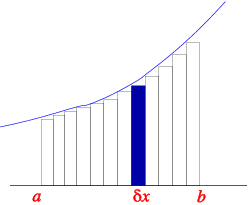
L&T, 19.12-22
Again consider curve y = f(x) from a to b, divided into strips of thickness δx. The area of the strip is given by (δA ≈ f((x))δx). The total area is given by the sum,
|
A ≈{\mathop{∑
}}_{a}^{b}δA ={ \mathop{∑
}}_{a}^{b}f(x)δx →{\mathop{\mathop{\mathop{∫
}\nolimits }}\nolimits }_{a}^{b}f(x)\kern 1.66702pt dx.
|
If the strip is very thin then all of it is approximately at a distance x from y axis. If we now add up NOT δA but instead δA times x, i.e., δA “weighted” by x, we get the first moment of the area about the x axis,
|
{M}_{x} ≈{\mathop{∑
}}_{a}^{b}xδA ={ \mathop{∑
}}_{a}^{b}xf(x)δx →{\mathop{\mathop{\mathop{∫
}\nolimits }}\nolimits }_{a}^{b}xf((x))\kern 1.66702pt dx\quad .
|
This is usually called {M}_{x}, even though it is the first moment around the y axis.
Example 6.5:
Find the first moment of area under y = 1 + x + {x}^{2} from x = 0 to x = 2 about the y axis.
Solution:
Example 6.6:
Find the first moment of the area under y = {e}^{−x} from x = 0 to x = 1 about the y axis.
Solution:
|
{M}_{x} ={\mathop{ \mathop{\mathop{∫
}\nolimits }}\nolimits }_{0}^{1}x{e}^{−x}\kern 1.66702pt dx.
|
Integrate by parts: u = x, du∕dx = 1, du = dx, dv = {e}^{−x}dx. Therefore dv∕dx = {e}^{−x}, and thus v = −{e}^{−x},
Now consider the same strip of thickness δx. On this strip y goes from 0 to f(x). Divide strip into segments of length δy as shown in Fig. 6.8. The area of such a segment is δyδx. The total area of strip is δA ≈{\mathop{\mathop{∑ }}\nolimits }_{y=0}^{f(x)}δyδx. In the limit that δy becomes infinitesimal we get
as before. Now instead of summing segments we can weight each of them by the value of y to get
To find {M}_{y} we have to add the contributions of all strips
This is the formula for the first moment of the area about the x axis (This integral is same as that for the volume of revolution except for the factor {1\over 2} outside the integral rather than π).
Example 6.7:
Find {M}_{y} for area under curve y = 1 + x + {x}^{2} from x = 0 to x = 2 (same area as in example xxxx(1))
Solution:
Therefore
For any plane shape with area A, the centroid is a point with coordinates ({x}_{C},{y}_{C}) given by {x}_{C} = 1∕A{M}_{x}, {y}_{C} = 1∕A{M}_{y}, where {M}_{x} is first moment of area about the y axis, and {M}_{y} is first moment of area about the x axis.
Example 6.8:
Find the centroid of the area under y = 1 + x + {x}^{2} from x = 0 to x = 2 using the previous two examples.
Solution:
We know that {M}_{x} = 26∕3 and {M}_{y} = 71∕5, and we just need to determine A,
Therefore
If we have thin plate with constant thickness then the centroid is the position of centre of mass (C of M). The C of M is the point at which all mass can be regarded as acting. Let mass per unit area be ρ: This will be constant if the thickness is constant (and material is of uniform composition). The total mass m = Aρ where A is area. Turning effect about y axis of mass m at (x,y) would be mx = Aρx. A strip of thickness δx, height f(x) has area f(x)δx. Mass would be ρf(x)δx. Total turning effect is {\mathop{\mathop{∑ }}\nolimits }_{a}^{b}xρf(x)δx →{\mathop{\mathop{\mathop{∫ }\nolimits }}\nolimits }_{a}^{b}xf(x)dx = ρ{M}_{x}, therefore Aρx = ρ{M}_{x}, therefore {x}_{C} = 1∕A{M}_{x}.